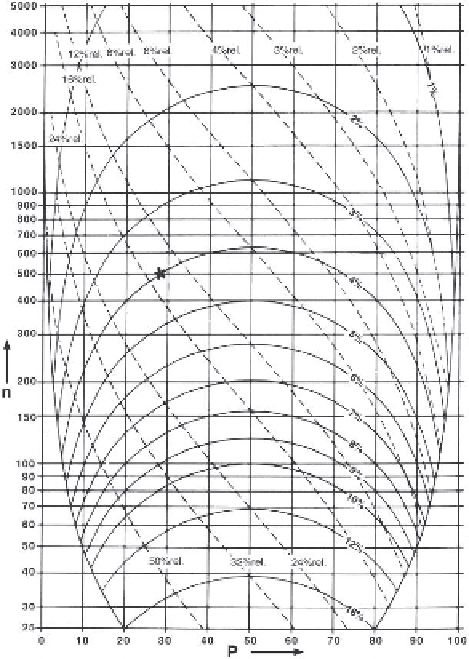Geology Reference
In-Depth Information
There is a magic number of 300 counts which is be-
lieved to provide sufficient accuracy of frequency mea-
surements. This often used figure is based on an equa-
tion for counting heavy mineral grains and on frequency
studies of modern foraminifers. The reliability of point
counting results can be judged using the chart devel-
oped by Van der Plas and Tobi (1965). This chart per-
mits the relationships between the number of points
counted and the accuracy of the result to be estimated
(Fig. 6.9). For a discussion of the number of point counts
needed for sufficient accuracy see Patterson and Fish-
bein (1989). One immediate and obvious shortcoming
of point-counting data is often that taken on their own
they do not display meaningful groupings without sta-
tistical treatment.
A general impression of the statical behavior of in-
dividual point-count groups can be obtained by calcu-
lating summary statistics for each variable of the point-
counting groups (see Sprenger and Ten Kate 1990 for
the software): Range (minimum and maximum values),
average (mean, median and mode), measures of dis-
persion (variance standard deviation and coefficient of
variations), and the confidence limits for the popula-
tion mean and variance. These statistics are important
if variations along a geological section are to be dis-
cussed.
F
ig. 6.9.
Chart for judging the reliability of point counting
results
after Van der Plas and Tobi (1965). The reliability is
expressed by the standard deviation s.
Key:
N = total num-
ber of points counted; P = estimated percentage of a grain in
the thin section. Full curves = 2 s values, dashed curves =
relative s values. Example 1 (asterisk): Consider an oolitic
grainstone. Out of 500 points counted 140 points (= 28%)
fall on ooids. Plotting these values on the chart leads to a
standard deviation of 2 s = 4% (dark line, absolute error).
This means that the ooid content of the samples lies between
28 ± 4% = 24 and 32% with a 95% confidence. If this error is
acceptable, the counting can be brought to a halt. If you agree
with a larger standard deviation of, e.g. 5%, you can stop
after counting 300 points. Note that the use of the chart re-
quires a point distance that is larger than the largest grain
included in the measurement.
(2) In
line counting
(Fig. 6.7B) all grains are mea-
sured that are intersected by lines across the section
spaced at intervals approximately equal to the diam-
eter of the largest particle. Line-counting of microfa-
cies samples is less useful than the other methods men-
tioned, but is a common and time-saving method in
field-based quantitative facies studies aiming at an un-
derstanding of paleoecological patterns. Results based
on line counting and point counting can differ by as
much as 10% (Flügel and Hötzl 1976; Bernecker et al.
1999). Another successful approach to line counting
are measurements of facies and microfacies variations
in cores (Sect. 17.1.4.2).
(3) In
area counting
(Fig. 6.7C) all grains lying
within a defined thin-section area are evaluated. Area
counting is a genuine number-frequency measurement.
The method can sometimes be compared with coarse
grain analysis used to investigate recent carbonate
sand-sizes sediments (Sarnthein 1971). A very promis-
ing variant of area counting is the foraminiferal abun-
dance analysis (Sect. 10.2.2.1).
are vertically separated by unassessed ribbons of a width
approximately equal to or twice the diameter of the larg-
est grain or just spaced randomly. Grains extending from
above into the ribbon are counted; those extending from
below into the ribbon remain uncounted.
Frequency index: A useful variant of area counting
Carozzi and his students developed a technique of
quantifying microfacies data by means of sets of varia-
tion curves drawn alongside the stratigraphic column.
Quantification starts by determining two indices, the
(4)
Ribbon counting
(Fig. 6.7D) requires measure-
ment of all grains occurring within ribbons oriented
parallel to the sedimentary bedding. Individual ribbons

